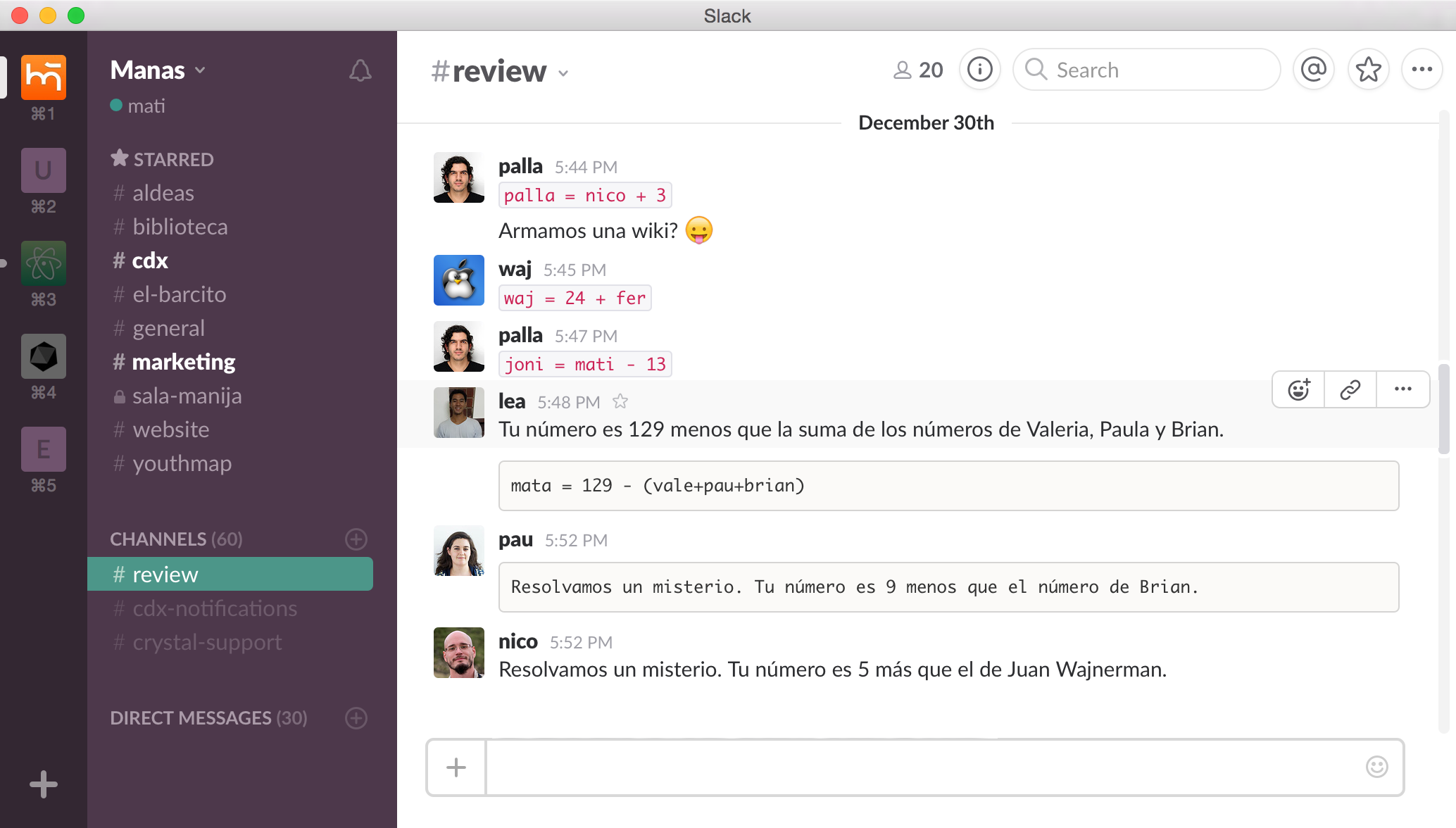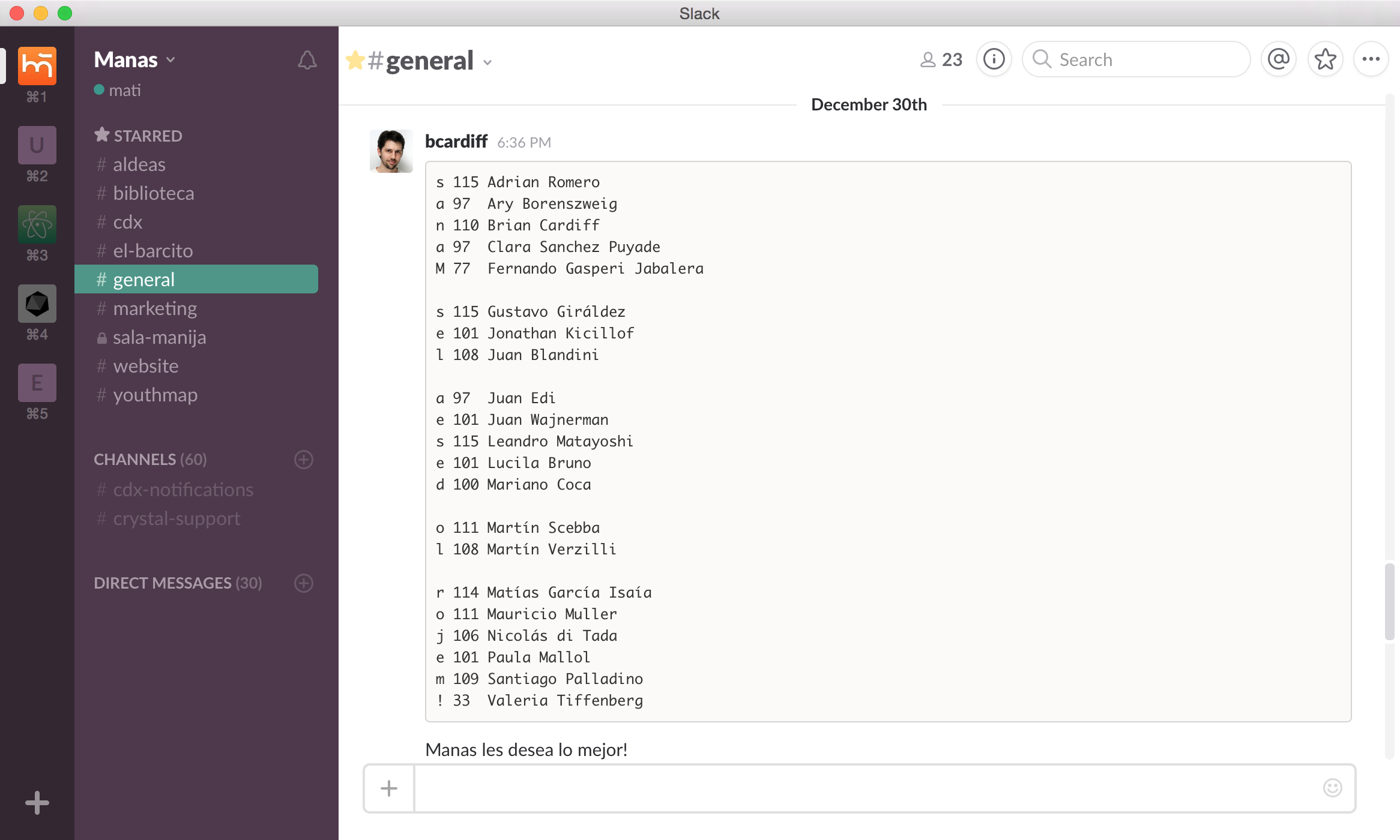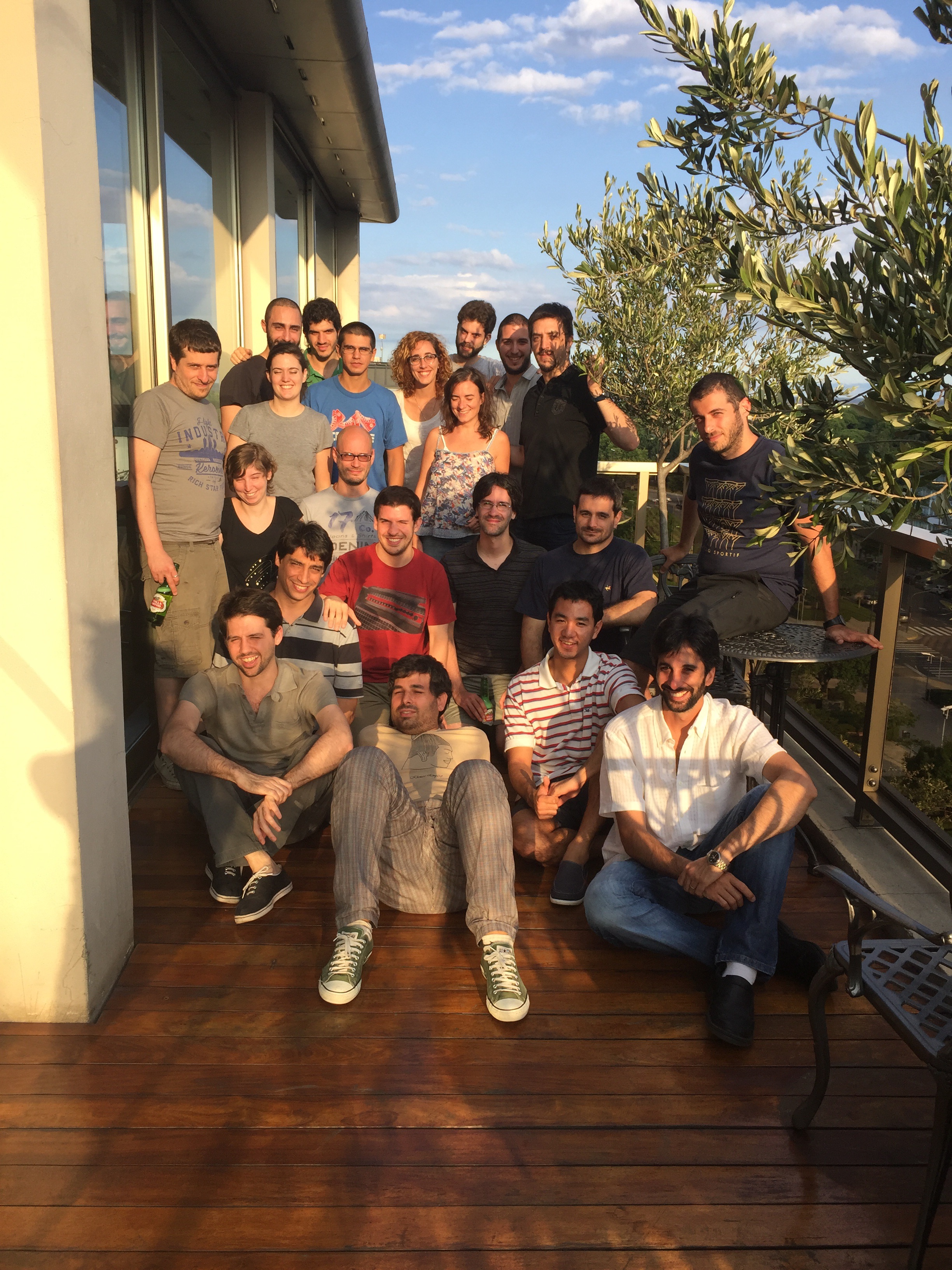Every six months everyone at Manas gather for a review. In this review, among other things, we decide the salary raises for everyone. In this process everyone decides how to split the available raise money between everyone else in the team. Then the effective raise you get is the average of the sum of amounts everybody else gave you.
For this, we made a web app that we run locally. You get to see everyone else in a list, and a text input next to each one where you choose the amount. But also, there are small links to leave anonymous comments to others, which you get to see when the process finishes. These comments usually end up being “Awesome work this time!” or “I really liked you doing this and that”, or something funny, sometimes signed by the one who wrote them to remove that anonymity.

Review
A few days before this last year’s review an idea came to my mind: could I somehow use those anonymous comments to make a puzzle that everyone, together, has to solve?
I’ll first tell you how it went, so you get a chance to almost experience the puzzle. Then I’ll write about the puzzle’s design process, followed by some conclusions.
Playing the puzzle
The last click that decides how to split the raise amounts have been given, and everyone had in their screen the final results, together with some anonymous comments. After a small silence some began to laugh and say “What’s this?” and “Who’s the funny one?”. Soon, everyone realized that they received a mysterious comment. It read like this: “Your number is Fernando’s number plus 17”, or “Your number is the sum of Santiago’s number plus Fernando’s number plus Valeria’s number minus 123”.
Because you can’t give yourself an anonymous comment, they started asking others to show their screen and check if they received the comment. They initially suspected Nico and me, but we both had the mysterious messages as well. There was someone else: Maria couldn’t be at the same place, but still did the review process and said that she didn’t receive a comment like that. Could she be the one behind all of this? She said “No”. Nobody knew what to believe, but at the same time were thinking about the equations.
At first people though a big system of equations was needed to be solved, but they soon realized this wasn’t the case, as, for example, Fernando’s, Santiago’s, Valeria’s and Brian’s numbers depended exclusively on the numbers of others in that smaller group. In short, there were five system of equations to solve.

Manas team
Gustavo began to solve one, and Valeria another one. After a couple of minutes Gustavo had a first answer: “My number is 115, Juan’s is 108, Martin’s is also 108 and Mauricio’s is 111.” Then Valeria finished solving theirs, but her numbers were “37.5” and others with a decimal point. She said “This isn’t right” and checked the instructions again and found a mistake, so she redid it and ended with “good” numbers like 33, 101, 110 and 115.
Valeria’s instructions also said “Also, your number is the last one in my list.” Her number is 33, so she thought “Maybe it’s the smallest one.”
Some started wondering what these numbers meant. Some jokes were said, but nobody had an idea.
After a while Juan said: “These are definitely ASCII codes”. So 115 is “s”, 108 is “l”, 111 is “o” and so on. “But how do we order them?”, asked Nico. And then he remembered: “Valeria, your instructions said that your number was the last one in the list, right? Anyone has the first one?”. It turned out Adrian’s instructions said so. Somebody said “So maybe the order is lexicographic?”
Brian opened his notebook and wrote the list of names, together with their given number and ASCII letter equivalent. It began to read “s__aMs__si_uoy__ttseb!”. They were puzzled, that didn’t make sense. But soon someone realized the words were reversed: the last letters “tseb” are “best”. And probably “s__aM” is “Manas”! After solving one more system of equations and deducing the rest of the letters, it read “sanaMsehsiwuofehttseb!”. They still couldn’t understand exactly the meaning, as reading it in reverse it says “best the fou wishes Manas!”
At that point I said “Time out!” and told them I made the puzzle, that the “f” was wrong (somebody wrote somebody else’s number wrong), that it was a “y”, and so they realized it reads (if you also reverse the word order): “Manas wishes you the best!”. “Awwwww…”, everyone said, in a cute tone.

Review message
(As a side note, the original message was “Manas les desea lo mejor!”, in Spanish, but I translated the message for the article.)
Designing the puzzle
I recently played a lot of puzzle games: The Talos Principle, Antichamber, Braid, Snakebird and Fez. The idea of giving everyone a letter, encoded in ASCII, immediately came to my mind.
I needed a message. Ideas like “At Manas we solve problems” came to my mind, which would have been kind of fun and recursive, but in Spanish that has long words that would be easy to find, even if not all of the equations were solved, so I opted for “Manas les desea lo mejor!”, which has shorter words and has the number of letters I needed.
There was a problem: I had a feeling that not everyone was going to solve their puzzle, only because I couldn’t just hope that everyone would be in the mood for that. I also wanted there to be interaction between the participants, so they could help each other and feel they are working together towards one goal. A system of equations seemed like a good fit for this. But, solving a huge system was going to be tedious and take a lot of time (if done manually, and I wanted it to be done like that, a reminiscence), so I decided to make smaller groups. The systems were all simple, like:
A = B + 11
B = C + 13
C = D - 23
D = A + B + C - 111
In this way you could replace values from the first equations in the next ones and find the solution. I didn’t care that it was relatively simple: the real puzzle, the needed “jump”, was noticing that these numbers were ASCII codes.
Then, of course, an ordering of the codes was missing. Lexicographical order seemed good too, so I gave a couple of clues about this. I originally decided to give an extra clue saying who is the second one in the list, but finally decided to have high hopes about my friends, and that they would solve this extra “jump”.
Finally, I wanted to introduce a last “jump”: the words and letters wouldn’t be ordered in the usual order, so they would have to realize this.
In total, three jumps were needed: ASCII codes, order of the codes, and order of the letters/words. Would they make it to the end?
In any case, the experiment was interesting: would they start solving the equations, or just leave them on the screen? And how many jumps would they accomplish? Would they like it?
At the review, the moment I started writing the anonymous comments I noticed a flaw: I couldn’t leave a comment to myself, they would find it was me. I thought about discarding the whole plan, but then an idea came to my mind: I could open the developer’s console and replace one of the comments I received with the puzzle instructions. I decided to do this, and as soon as the review was over did it, and luckily, because they asked me to show my screen!
As they solved the puzzles I decided to join and help them. It was tough, because I had to pretend I didn’t know anything about it.
Conclusion

Manas team
It was really awesome to see everyone having fun, laughing and thinking about possible solutions and meanings.
Some days after the puzzle was over I asked Gustavo and Valeria if, at the moment when they found out their numbers, they thought the numbers had a second meaning. They both said “No”, that they took that as a challenge, something to solve. I think that’s nice, to do something without expecting a reward of some kind, just for the fun of it.
I also thought about what would have happened if I introduced the puzzle without the mystery surrounding it. Would they still want to solve it? Valeria said “Come on, you know us. You know we would have wanted to solve it.”
